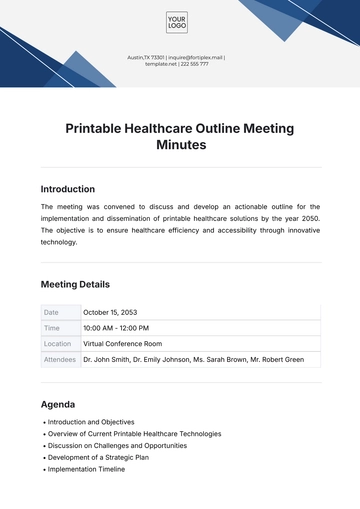Free Physical Therapy Case Study

I. Introduction
The Physical Therapy Case Study Template offers a methodical outline for recording patient cases. It briefs the patient's background, medical history, and main concerns to guide the case study's purpose and objectives. It illustrates the journey of a [Age]-year-old patient named [Patient Name] with [Condition], treated at [Your Company Name], aiming to supply practical information for physical therapy students and professionals.
II. Patient History and Assessment
In this section, detailed information regarding the patient's medical history, initial assessment findings, and relevant diagnostic tests are presented. It provides a comprehensive understanding of the patient's condition, contributing factors, and baseline functional status.
Medical History: [Patient Name]'s medical history includes [relevant medical conditions], previous injuries, surgeries, and any chronic health issues impacting their musculoskeletal system.
Presenting Complaints: [Patient Name] presented with complaints of [symptoms], which significantly impacted their daily activities and quality of life.
Initial Assessment Findings: Upon evaluation, findings revealed [specific impairments or limitations], such as reduced range of motion, muscle weakness, or balance deficits.
Diagnostic Tests: [Any diagnostic tests], such as X-rays, MRI scans, or clinical tests, were conducted to further assess the underlying pathology and inform the treatment plan.
III. Treatment Plan and Interventions
This section outlines the physical therapy interventions implemented to address the patient's presenting concerns and achieve therapeutic goals. It includes details of the treatment modalities, exercise programs, manual techniques, and patient education strategies utilized throughout the rehabilitation process.
Goals of Treatment: The treatment plan aimed to alleviate chronic lower back pain, increase range of motion in the lumbar spine, strengthen core musculature, and enable the patient to resume daily activities without discomfort.
Intervention Strategies: Various intervention strategies were employed, including therapeutic exercises, spinal manipulation, myofascial release, and postural re-education, tailored to address the patient's unique needs and functional limitations.
Exercise Prescription: A customized exercise program was developed, focusing on core stabilization exercises, lumbar flexibility drills, and proprioceptive training to target muscle imbalances, improve joint mobility, and promote neuromuscular control.
Manual Therapy Techniques: Manual therapy techniques such as soft tissue mobilization, joint mobilization, and instrument-assisted soft tissue mobilization were incorporated to address soft tissue restrictions, and joint dysfunctions, and promote tissue healing.
Patient Education: [Patient Name] received education on proper lifting techniques, ergonomic principles for workstation setup, home exercise instructions, and stress management strategies to optimize long-term outcomes.
IV. Progress and Outcomes
This section documents the patient's progress throughout physical therapy treatment, highlighting improvements in functional abilities, pain levels, and overall quality of life. Objective measures, functional assessments, and patient-reported outcomes are used to track progress and evaluate the effectiveness of the intervention.
Progress Monitoring: Regular checks on [Patient Name]'s progress included objective evaluations like movement, strength, functional screenings, pain scales, and functional assessments like Oswestry and Roland-Morris questionnaires, along with symptom reports.
Outcome Measures: Objective outcome measures such as the Visual Analog Scale (VAS) for pain, the Modified Schober Test for lumbar flexion, and the Plank Test for core stability were utilized to quantify improvements in pain levels, lumbar flexibility, and core strength, providing valuable data on treatment efficacy.
Functional Gains: [Patient Name] has made significant progress in their functional abilities during treatment. They've seen improved lumbar motion, core stability, and daily activity performance without pain, such as tying shoes without discomfort and extended sitting without stiffness.
Pain Management: The intervention significantly relieved [Patient Name]'s severe pain, dropping his VAS score from 7/10 to 2/10, improving his pain management, and reducing his need for medication.
Patient Satisfaction: [Patient Name]'s feedback on treatment experience and satisfaction with results, including gratitude for personalized care and progress in managing his lower back pain, has been recorded.
V. Discussion and Conclusion
This section discusses the case study findings within current literature and best practices. It explores their clinical, research, and future implications and summarizes the key points. The findings align with previous research on [Interventions] managing [Condition], but also acknowledge limitations and suggest areas for further improvement and research.
This Physical Therapy Case study on [Patient Name] with [condition] offers critical insights into diagnosis, treatment, and results, highlighting the role of physical therapy in improving function and life quality. The study, contributing to the physical therapy field, emphasizes the significance of evidence-based practice for better treatment decisions and patient care.
Prepared By:
[Your Name]
[Your Title/Position]
[Your Department]
- 100% Customizable, free editor
- Access 1 Million+ Templates, photo’s & graphics
- Download or share as a template
- Click and replace photos, graphics, text, backgrounds
- Resize, crop, AI write & more
- Access advanced editor
Transform patient care narratives with the Physical Therapy Case Study Template, exclusively on Template.net. Tailored for healthcare professionals, this editable and customizable tool provides a comprehensive platform to document treatment journeys with precision. Seamlessly adapt your insights, as it's editable in our AI Editor Tool, ensuring every therapy success story is captured and shared effectively, elevating standards of care.





























